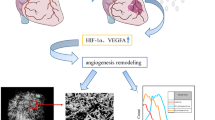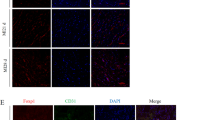Abstract
Vascular endothelial growth factor (VEGF) is a hypoxia-inducible factor expressed into several molecular forms in mammalian tissues of which VEGF120, VEGF164, and VEGF188 are the major isoforms. While VEGF164 is the predominant isoform in most tissues, VEGF188 has been reported to be dominant in cardiac tissues such as that in guinea pig, rat, and mouse. In the dog heart, an important model for studies of myocardial ischemia and angiogenesis, the expression of VEGF remains to be established. We investigated the expression of the various isoforms of VEGF in normal and ischemic dog heart tissues using Reverse transcription-Polymerase chain reaction, Ribonuclease Protection Assay and Western blotting. The nucleotide sequences of the major isoforms of VEGF were also determined using homology cloning techniques. Our study showed that the nucleotide sequences of dog VEGF were highly homologous to human VEGF especially in the c-terminal region spanning exons 5-8. A single amino acid-deletion (Glu5 in human VEGF), similar to that reported in other animal species, was observed in the major isoforms resulting in monomers of 120, 164, and 188 amino acids. A novel splice site similar to that in human VEGF183 was also identified in the dog heart, resulting in the 182 amino acid-containing isoform (VEGF182). Moreover, VEGF164 was expressed at a higher level as compared with VEGF182 or VEGF188 in both normal and ischemic tissues. The identification of the nucleotide sequences of VEGF isoforms in the dog heart should prove useful in investigating the molecular expression of VEGF in canine tissues.
Similar content being viewed by others
References
Connolly D, Heuvelman D, Nelson R, Olander J, Eppley B, Delfino J, Siegel N, Leimgruber R, Feder J: Tumor vascular permeability factor stimulates endothelial cell growth and angiogenesis. J Clin Invest 84: 1470–1478, 1989
Leung D, Cachianes G, Kuang W, Goeddel D, Ferrara N: Vascular endothelial growth factor is a secreted angiogenic mitogen. Science 246: 1306–1309, 1989
Pierce EA, Avery RL, Foley ED, Aiello LP, Smith LEH: Vascular endothelial growth factor/vascular permeability factor expression in a mouse model of retinal neovascularization. Proc Natl Acad Sci USA 92: 905–909, 1995
Lutty GA, McLeod S, Merges C, Diggs A, Plouet J: Localization of vascular endothelial growth factor in human retina and choroid. Arch Ophthalmol 114: 971–977, 1996
Minchenko A, Bauer T, Salceda S, Caro J: Hypoxic stimulation of vascular endothelial growth factor expression in vitro and in vivo. Lab Invest 71: 374–379, 1994
Shweiki D, Itin A, Soffer D, Keshet E: Vascular endothelial growth factor induced by hypoxia may mediate hypoxia-initiated angiogenesis. Nature 359: 843–845, 1992
Shima DT, Gougos A, Miller JW, Tolentino M, Robinson G, Adamis AP, D'Amore PA: Cloning and mRNA expression of vascular endothelial growth factor in ischemic retinas of macaca fascicularis. Invest Ophthalmol Vis Sci 37: 1334–1340, 1996
Stone J, Itin A, Alon T, Pe'er J, Gnessin H, Chan-Ling T, Keshet E: Development of retinal vasculature is mediated by hypoxia-induced vascular endothelial growth factor (VEGF) expression by neuroglia. J Neurosci 15: 4738–4747, 1995
Sabri MN, DiSciascio G. Crowley MJ, Alpert D, Vetrovec GW: Coronary collateral recruitment: Functional significance and relation to rate of vessel closure. Am Heart J 121: 876–880, 1991
Banai S, Jaklitsch MT, Shou M, Lazarous DF, Scheinowitx M, Biro S, Epstein SE, Unger EF: Angiogenic-induced enhancement of collateral blood flow to ischemic myocardium by vascular endothelial growth factor in dogs. Circulation 89: 2183–2189, 1994
Ferrara N, Houck KA, Jakeman LB, Winer J, Leung DW: The vascular endothelial growth factor family of polypeptides. J Cell Biochem 47: 211–218, 1991
Jingjing L, Xue Y, Agarwal N, Roque RS: Human Mü ller cells express VEGF183, a novel spliced variant of vascular endothelial growth factor. Invest Ophthalmol Vis Sci 40: 752–759, 1999
Poltorak Z, Cohen T, Sivan R, Kandelis Y, Spira G, Vlodavsky I, Keshet E, Neufeld G: VEGF145, a secreted vascular endothelial growth factor isoform that binds to extracellular matrix. J Biol Chem 272: 7151–7158, 1997
Houck KA, Ferrara N, Winer J, Cachianes G, Li B, Leung DW: The vascular endothelial growth factor family: Identification of a fourth molecular species and characterization of alternative splicing of RNA. Mol Endocrinol 5: 1806–1814, 1991
Ladoux A, Frelin C: Hypoxia is a strong inducer of vascular endothelial growth factor mRNA expression in the heart. Biochem Biophys Res Commun 195: 1005–1010, 1993
Sharma HS, Tang ZH, Gho BCG, Verdouw PD: Nucleotide sequence and expression of the porcine vascular endothelial growth factor. Biochim Biophys Acta 1260: 235–238, 1995
Hashimoto E, Ogita T, Nakaoka T, Matsuoka R, Takao A, Kira Y: Rapid induction of vascular endothelial growth factor expression by transient ischemia in rat heart. Am J Physiol 267: H1948–H1954, 1994
Li J, Brown LF, Hibberd MG, Grossman JD, Morgan JP, Simons M: VEGF, flk-1, and flt-1 expression in a rat myocardial infarction model of angiogenesis. Am J Physiol 270: H1803–H1811, 1996
Zacharias DA, Garamszegi N, Strehler EE: Characterization of persistent artifacts resulting from RT-PCR of alternatively spliced variants. Biotechniques 17: 652–655, 1994
Deidl E, Schaper W: Gene expression after short periods of coronary occlusion. Mol Cell Biochem 186: 43–51, 1998
Author information
Authors and Affiliations
Rights and permissions
About this article
Cite this article
Jingjing, L., Srinivasan, B., Bian, X. et al. Vascular endothelial growth factor is increased following coronary artery occlusion in the dog heart. Mol Cell Biochem 214, 23–30 (2000). https://doi.org/10.1023/A:1007115502758
Issue Date:
DOI: https://doi.org/10.1023/A:1007115502758




